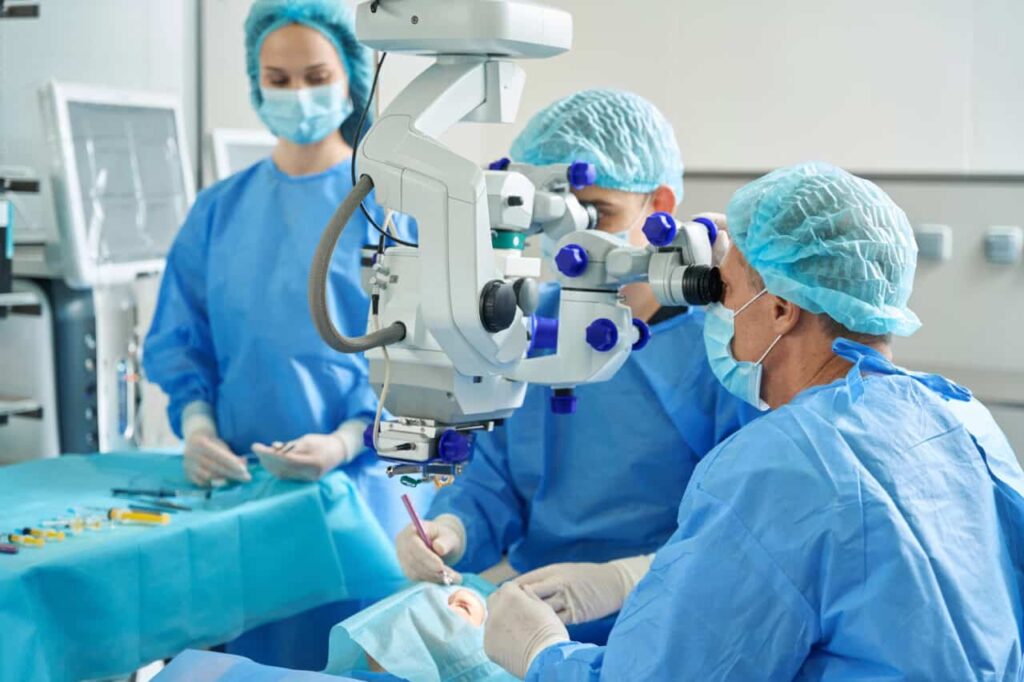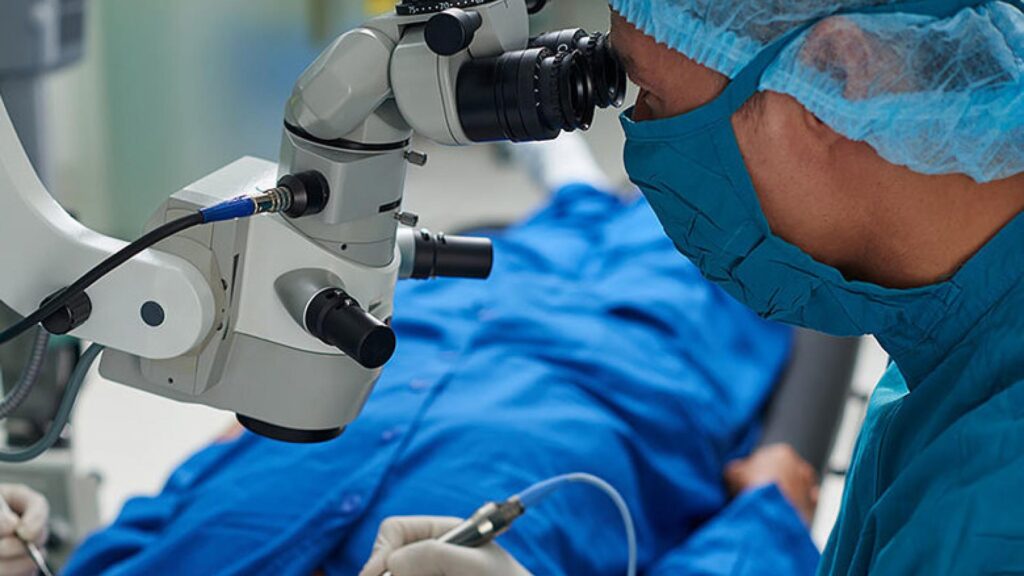Glaucoma is a serious eye condition that can lead to vision loss if left untreated. It is important to understand what glaucoma is and how it affects the eye in order to appreciate the benefits of glaucoma surgery. By exploring the anatomy of the eye and the role of intraocular pressure, we can gain a deeper understanding of this condition.
What is Glaucoma?
Glaucoma is a group of eye diseases that damage the optic nerve, which is responsible for transmitting visual information from the eye to the brain. This damage is often caused by an increase in intraocular pressure, the fluid pressure inside the eye. If left untreated, glaucoma can lead to permanent vision loss.
When other treatment options are not effective in managing glaucoma surgery may be recommended. The goal of glaucoma surgery is to reduce intraocular pressure and prevent further damage to the optic nerve.
The Anatomy of the Eye
To understand Glaucoma Surgery, it is important to have a basic understanding of the anatomy of the eye. The eye consists of several parts including the cornea, iris, lens, and retina. The cornea is the clear, dome-shaped front portion of the eye that helps to focus light onto the retina. The retina is the light-sensitive tissue at the back of the eye, which sends signals to the brain via the optic nerve.
The iris, the colored part of the eye, controls the size of the pupil, which is the opening that allows light to enter the eye. The lens, located behind the iris, helps to focus light onto the retina. This complex interplay of structures allows the eye to process visual information and send it to the brain for interpretation.
The Role of Intraocular Pressure
Intraocular pressure refers to the fluid pressure inside the eye. It is produced by the constant production and outflow of fluid called aqueous humor. Normally, the fluid flows out of the eye through a drainage system. However, in glaucoma, this drainage system becomes blocked or inefficient, resulting in an increase in intraocular pressure. This elevated pressure can damage the optic nerve over time, leading to vision loss.
It is crucial for individuals at risk of glaucoma to have regular eye examinations to monitor their intraocular pressure and overall eye health. Early detection and treatment of glaucoma can help prevent irreversible vision loss and preserve the individual’s quality of life. By understanding the intricate anatomy and physiology of the eye, healthcare professionals can better educate patients on the importance of proactive eye care and the management of conditions like glaucoma. Know more about individual’s quality of life at https://www.ncbi.nlm.nih.gov/books/NBK536962/

Different Types of Glaucoma
There are several types of glaucoma, but the two most common types are open-angle glaucoma and angle-closure glaucoma.
Glaucoma is a group of eye conditions that damage the optic nerve, often due to an increase in intraocular pressure. This can lead to vision loss and blindness if left untreated. While open-angle and angle-closure glaucoma are the most prevalent forms, there are other types such as normal-tension glaucoma, pigmentary glaucoma, and secondary glaucoma.
Open-Angle Glaucoma
Open-angle glaucoma is the most common form of glaucoma. It occurs when the drainage system of the eye becomes clogged over time, leading to a gradual increase in intraocular pressure. This increase in pressure damages the optic nerve and causes peripheral vision loss. Open-angle glaucoma typically progresses slowly and may not cause noticeable symptoms until the later stages.
Individuals with open-angle glaucoma may not realize they have the condition until significant vision loss has occurred. Regular eye exams are crucial for early detection and management of open-angle glaucoma. Treatment options include eye drops, oral medications, laser therapy, and surgery, depending on the severity of the condition.
Angle-Closure Glaucoma
Angle-closure glaucoma, also known as closed-angle glaucoma, occurs when the drainage canals in the eye become blocked suddenly. This causes a rapid increase in intraocular pressure, leading to severe symptoms such as eye pain, blurred vision, and nausea. Angle-closure glaucoma is considered a medical emergency and requires immediate treatment to prevent permanent vision loss.
Individuals with angle-closure glaucoma may experience sudden and intense symptoms, including halos around lights, headaches, and eye redness. Prompt medical attention is essential to relieve the pressure in the eye and prevent further damage to the optic nerve. Treatment for angle-closure glaucoma may involve medications to lower intraocular pressure, laser peripheral iridotomy to improve drainage, or surgery to create a new drainage channel.
Symptoms and Diagnosis of Glaucoma
Recognizing the signs of glaucoma is crucial for early diagnosis and treatment. Although the symptoms can vary depending on the type of glaucoma, there are a few common signs to watch out for.
Glaucoma is often referred to as the “silent thief of sight” because it can progress slowly and without any noticeable symptoms in the early stages. This is why regular eye exams are crucial, especially for individuals at higher risk, such as those with a family history of the disease, individuals over the age of 60, or people with certain medical conditions like diabetes. To read more about medical conditions click here.
Recognizing the Signs of Glaucoma
Some common symptoms of glaucoma include blurred vision, halos around lights, difficulty adjusting to low light, and loss of peripheral vision. However, in the early stages, glaucoma may not cause noticeable symptoms, which is why regular eye exams are essential for early detection.
Another important symptom to watch out for is eye pain or redness, especially when accompanied by nausea and vomiting, as this could indicate an acute angle-closure glaucoma attack, which is a medical emergency requiring immediate attention to prevent vision loss.
Diagnostic Procedures for Glaucoma
If glaucoma is suspected, your eye doctor will perform a series of tests to diagnose the condition. These may include a visual acuity test, tonometry to measure intraocular pressure, and a visual field test to assess peripheral vision. In some cases, additional imaging tests such as optic nerve imaging or gonioscopy may be required to further evaluate the condition.
Early diagnosis and treatment of glaucoma are essential in preventing irreversible vision loss. Once diagnosed, treatment options may include prescription eye drops to reduce intraocular pressure, laser therapy, or in severe cases, surgery to improve fluid drainage from the eye and reduce pressure. It is important to follow your eye doctor’s recommendations closely and attend regular follow-up appointments to monitor the progression of the disease and adjust treatment as needed.
An Overview of Glaucoma Surgery
Glaucoma, often referred to as the “silent thief of sight,” is a group of eye conditions that can lead to irreversible vision loss if left untreated. It is characterized by increased intraocular pressure, which can damage the optic nerve and result in gradual vision loss. Glaucoma surgery plays a crucial role in managing the disease and preserving the patient’s eyesight.
The Goal of Glaucoma Surgery
The primary objective of glaucoma surgery is to lower the intraocular pressure to a level that will not cause further damage to the optic nerve. By reducing intraocular pressure, glaucoma surgery aims to preserve the remaining vision and prevent further visual deterioration.
Furthermore, glaucoma surgery can help alleviate symptoms such as eye pain, headaches, and blurred vision, improving the patient’s overall quality of life. It is essential for individuals with glaucoma to undergo regular eye examinations to monitor the progression of the disease and determine the most appropriate treatment plan, which may include surgical intervention.
Common Surgical Procedures for Glaucoma
There are several surgical procedures that can be used to treat glaucoma, depending on the severity and type of the condition. Some common surgical interventions include trabeculectomy, which creates a new drainage channel to allow the excess fluid to drain out of the eye, and tube shunt implantation, which involves the insertion of a small tube to redirect the fluid flow and lower the intraocular pressure.
In addition to these procedures, laser surgery, such as selective laser trabeculoplasty (SLT) and laser peripheral iridotomy (LPI), may also be recommended for certain types of glaucoma. These minimally invasive techniques use focused laser energy to improve the outflow of fluid from the eye, reducing intraocular pressure and helping to preserve vision.

The Benefits of Glaucoma Surgery
Glaucoma surgery offers several benefits to patients suffering from this condition.
Preservation of Vision
One of the primary benefits of glaucoma surgery is the preservation of vision. By reducing intraocular pressure and preventing further damage to the optic nerve, glaucoma surgery can help maintain the remaining vision and slow down the progression of the disease. This can significantly improve the quality of life for individuals with glaucoma.
Reduction of Symptoms
Glaucoma surgery can also help reduce the symptoms associated with the condition. By lowering intraocular pressure, surgery can alleviate symptoms such as blurred vision, halos, and eye discomfort. This can result in improved visual clarity and overall comfort for patients.
Furthermore, glaucoma surgery can have a positive impact on the overall well-being of patients. By addressing the underlying cause of vision loss and taking proactive steps to manage the condition, individuals undergoing glaucoma surgery often experience a sense of empowerment and control over their eye health. This can lead to increased confidence and a more positive outlook on the future.
Overall, glaucoma surgery plays a crucial role in the management of this sight-threatening condition. By understanding the anatomy of the eye, the role of intraocular pressure, and the different types of glaucoma, we can appreciate the importance of early diagnosis and the benefits of timely intervention through surgical procedures. If you suspect you may have glaucoma or are concerned about your eye health, it is important to consult with an eye care professional to discuss the best course of action for your specific needs.
Learn more.

